If you think you’ve seen all of Kashmir, think again!
In the most sensitive region of the India in the proximity of LoC, there lies Tulail Valley.
A valley so stunning yet so unknown, a place so peaceful yet so close to the Line of Control (LoC).
Tucked deep in the Gurez region, this hidden gem is untouched by mass tourism.
But getting here isn’t easy.
Are you ready for the challenge? Here’s your ultimate guide to exploring Kashmir’s best-kept secret.

Table of Contents
Tulail Valley: A Location So Close to the Border, Yet So Far From the World
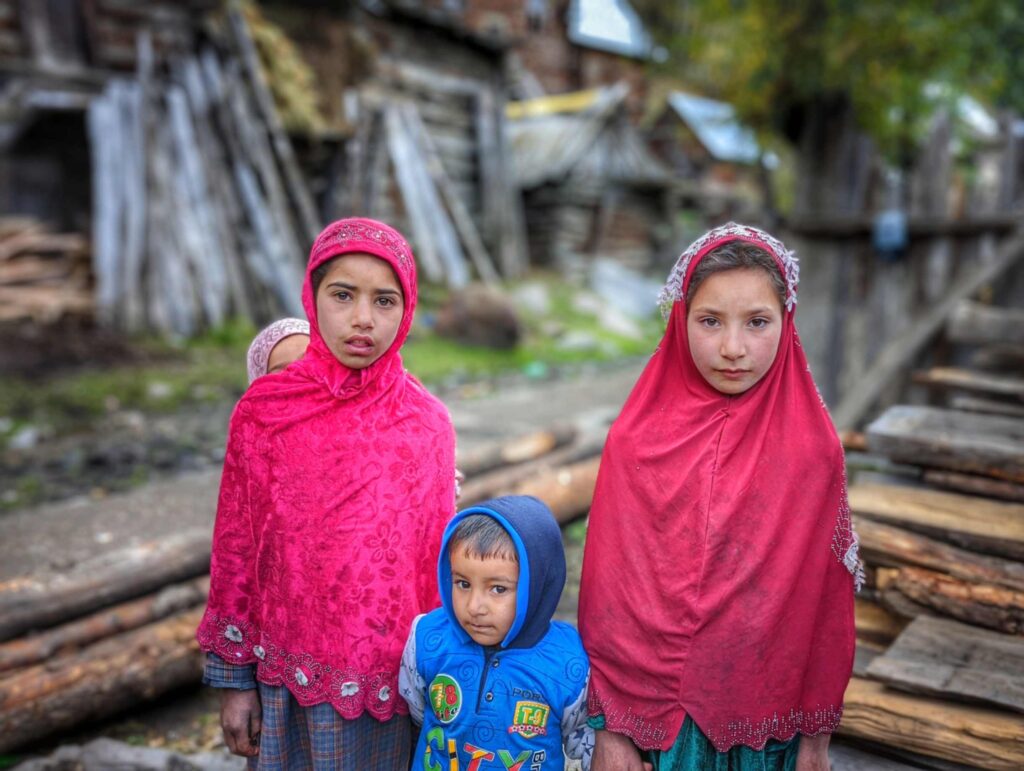
Did you know that Tulail Valley is closer to Gilgit-Baltistan than to Srinagar?
Basically, Tulail valley is extension of Gurez Valley. This valley is approximately 60 kilometers northeast of Dawar, the central town of Gurez.
Tulail valley stretches from Barnoi to Chakwali, encompassing around 15 to 20 villages.
This untouched valley remains off-limits to most tourists due to its sensitive location near the Line of Control (LoC).
Geographically, Tulail Valley is situated at an average altitude of 2,750 meters and is characterized by its lush meadows, dense forests, and the east-to-west flowing Kishanganga River.
The valley is bordered by the Gurez Valley to the west, Mushkoh Valley and Drass town to the east, the Kashmir Valley to the south, and the Astore District in Gilgit-Baltistan across the Line of Control to the north.
Access to Tulail Valley is challenging; it is connected by a 200-kilometer road from Srinagar via Bandipora and the Razdan Pass. This route remains closed for about six months each year due to heavy snowfall.
Additionally, a road links Tulail to Drass over the Kabul Gali pass and through the Mushkoh Valley, but this is primarily used by the Indian Army, with civilian access restricted.
Despite being one of Kashmir’s most beautiful spots, Tulail remains a well-guarded secret. But if you’re an explorer seeking the road less traveled, here’s everything you need to know before visiting this paradise.
Foreigners need special permit to visit Gurez Valley & they can be taken at Bandipora. However these permits are not guaranteed. Hence foreigners are requested to keep track on local news for guidelines related to permit before planning trip here.
Brief short Itinerary for Tulail valley
- Day 1- Travel from Srinagar to Dawar (130 km) via Razdan pass. Explore Dawar town and Khandyal top.
- Day 2- From Dawar to Angaikot via Barnoi, Badugam and Husangam.
- Day 3- From Dawar to Sheikhpora and return back to Dawar
- Day 4- From Dawar to Srinagar (130km)
Please note that this is just a brief Itinerary. You can also have a stay in Sheikhpora village. Also keeping buffer days, will help you to keep your itinerary flexible.
Tulail Valley’s Timeless Villages: A Glimpse into Tranquility.
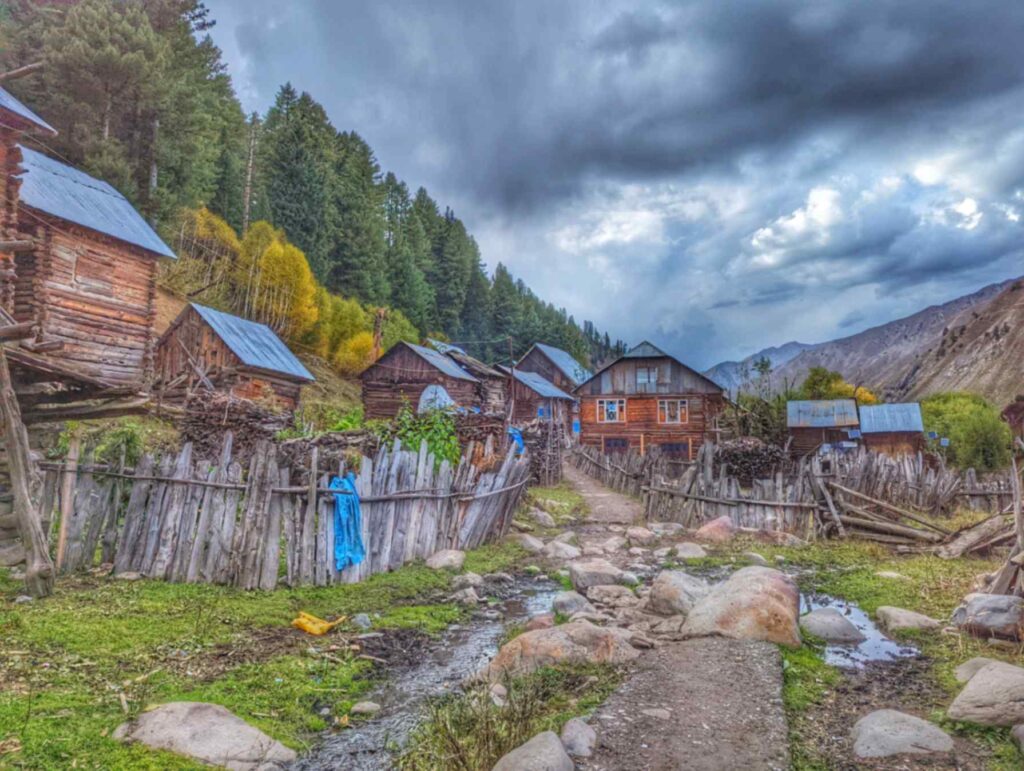
You wake up to the quiet hush of the Himalayas, where the only sounds are of gushing river & chitchatting sheeps.
Suddenly you’re not just a traveler anymore!
You’re a seeker of serenity!
The silent Tulail Valley, hidden deep within the folds of Jammu and Kashmir, welcomes you like a secret shared in a whisper. This is where time slows down.
Before entering Tulail valley, first you arrive in Gurez Valley into the town of Dawar.
And as you continue your journey through the valley’s most untouched villages, i.e Barnoi, Husangam, Badogam, Angaikot, and Sheikhpura, you begin to understand what it means to be wrapped in peace.
Dawar
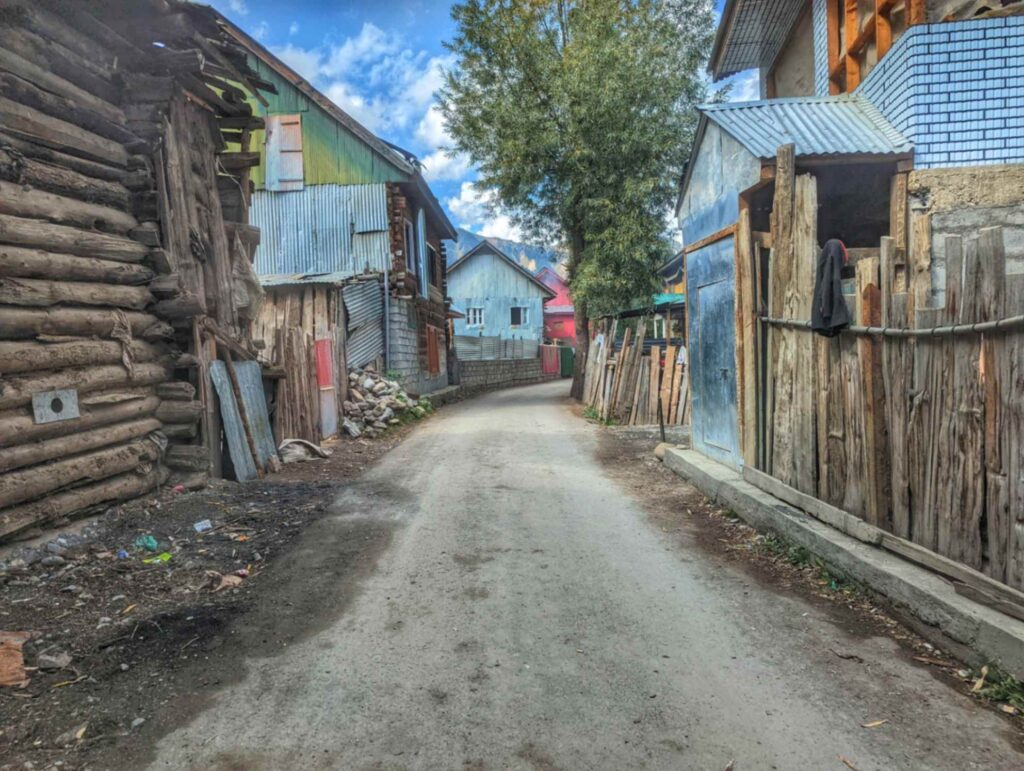
As you walk into Dawar, a quiet little town tucked away in the Gurez Valley of Jammu and Kashmir, everything feels like a dream. The cool breeze brushes your face, and the Kishanganga River flows beside you, calm and clear. Right in front of you, the mighty Habba Khatoon mountain rises like a story waiting to be told.
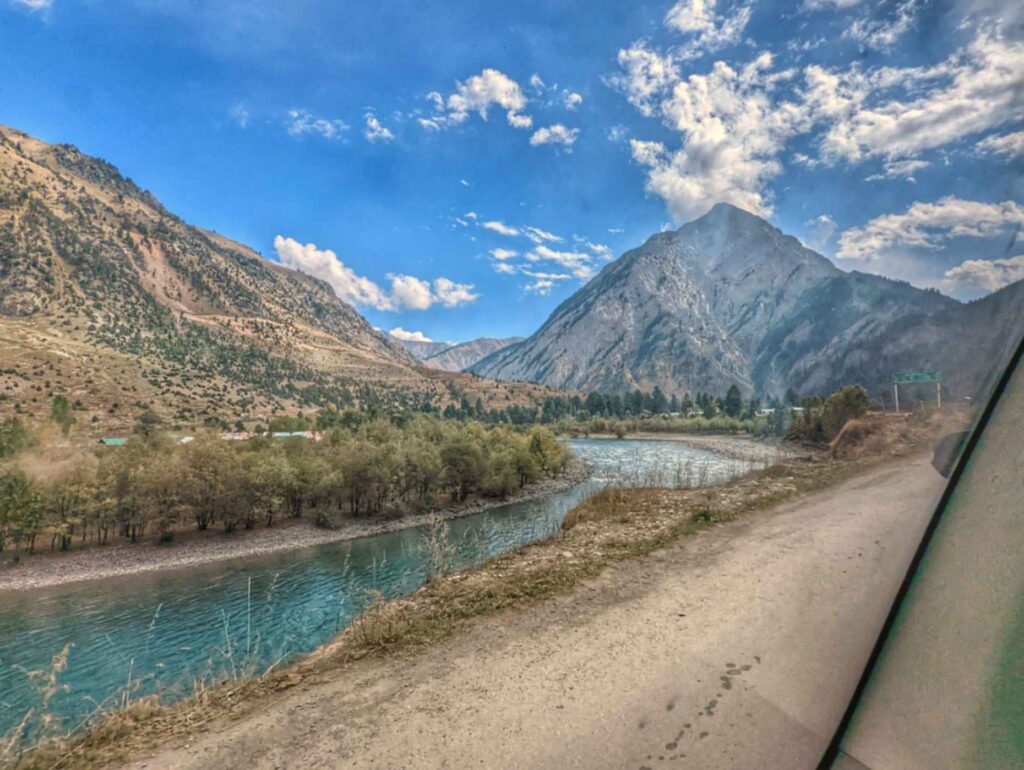
You take a deep breath & the air smells fresh and earthy. The people smile at you, friendly and welcoming.
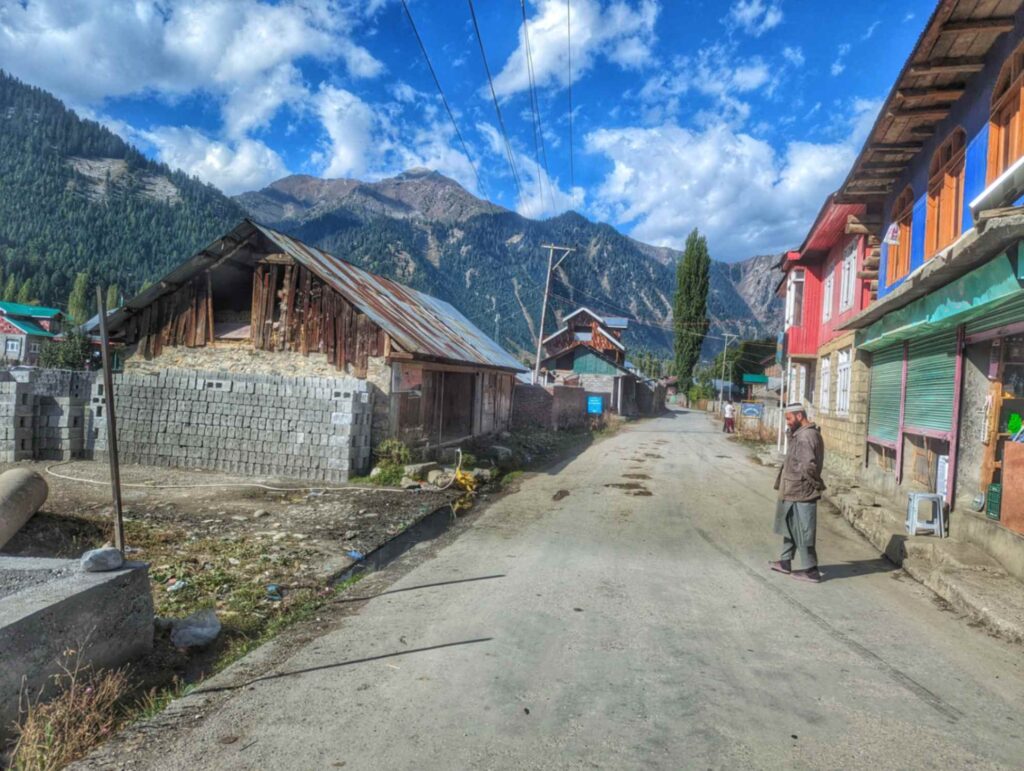
Their homes are made of wood, warm and beautiful, with carvings that seem to speak of old times. Kids laugh as they play near the river, and in small shops, you see locals making traditional woolen shawls and clothes, rich in color and culture.
You decide to follow a trail that leads to the Habba Khatoon Spring. Along the way, Kishanganga river is your constant companion. The path winds gently, giving you perfect views of the valley below.
At night, you curl up in a cozy homestay. The sound of the river outside helps you fall asleep with a smile.
Barnoi
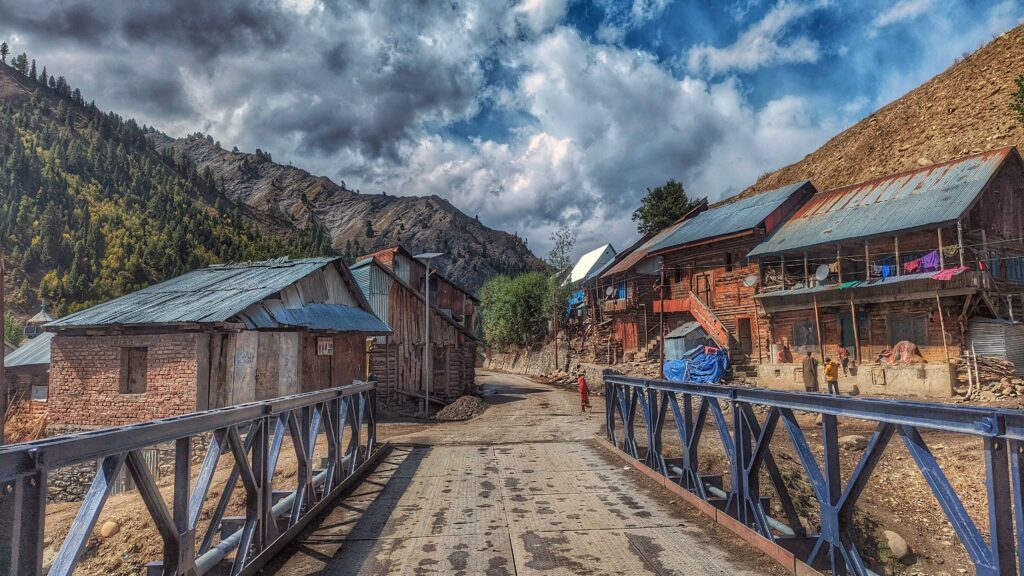
Your feet touch the soft earth of Barnoi, and you feel like you’ve stepped into a painting. Children’s laughter carries in the wind and every elder greets you with a nod of ancient wisdom.
Here, life unfolds slowly , a woman kneads dough outside her wooden home, smoke curls from a distant chimney, and barren mountain peaks form the backdrop to everything.
Husangam
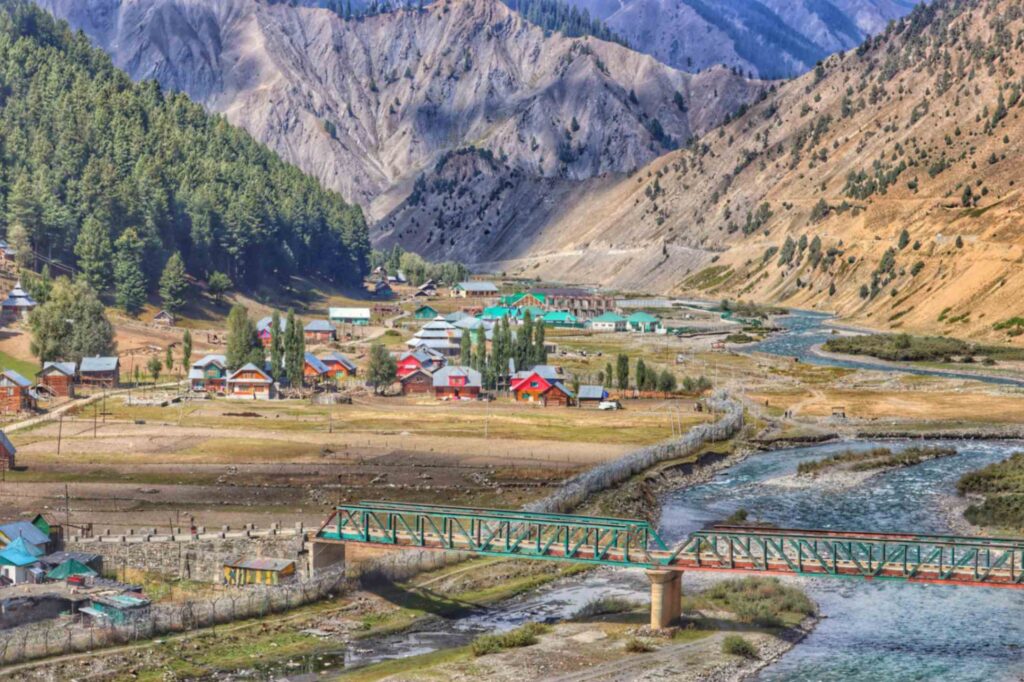
You follow the way to Husangam and the landscape opens up to warm homes made of timber and stone.
The village holds stories of centuries ago. You meet friendly locals with deep eyes and rough hands.
You sit with a cup of kashmiri kahwa in your hand, and suddenly, your heartbeat matches the rhythm of this quiet world.
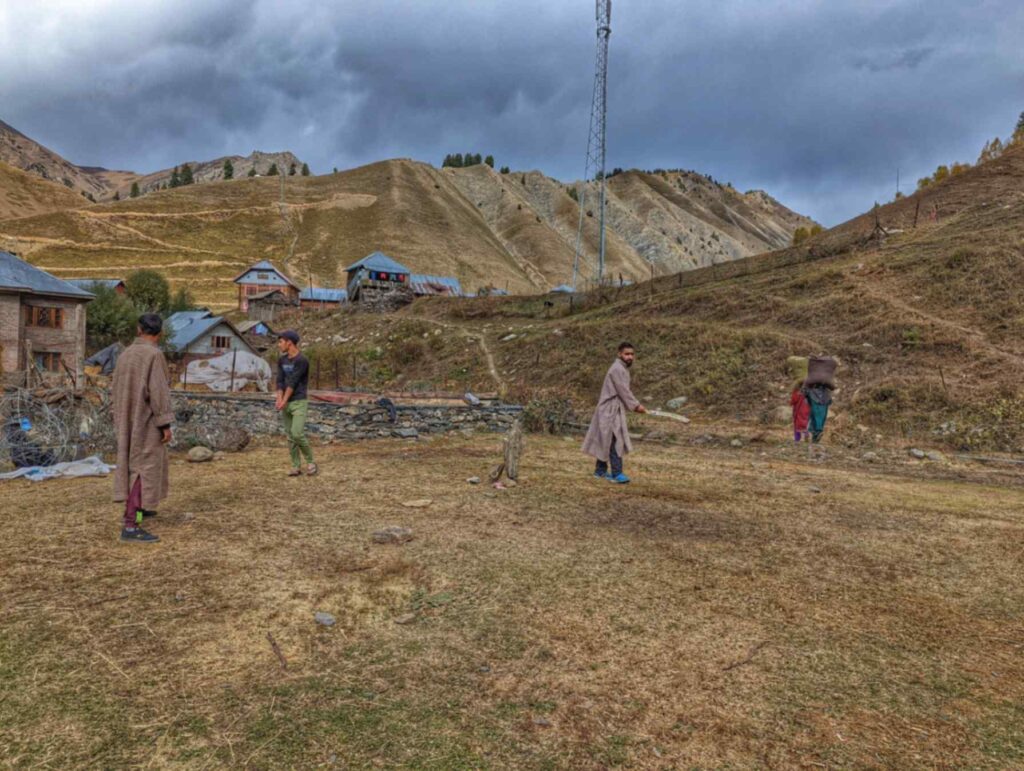
You see boys playing cricket in open meadows, grandmothers shelling walnuts on wooden verandas, and young girls braiding each other’s hair , giggling about dreams you’ll never know.
Badogam
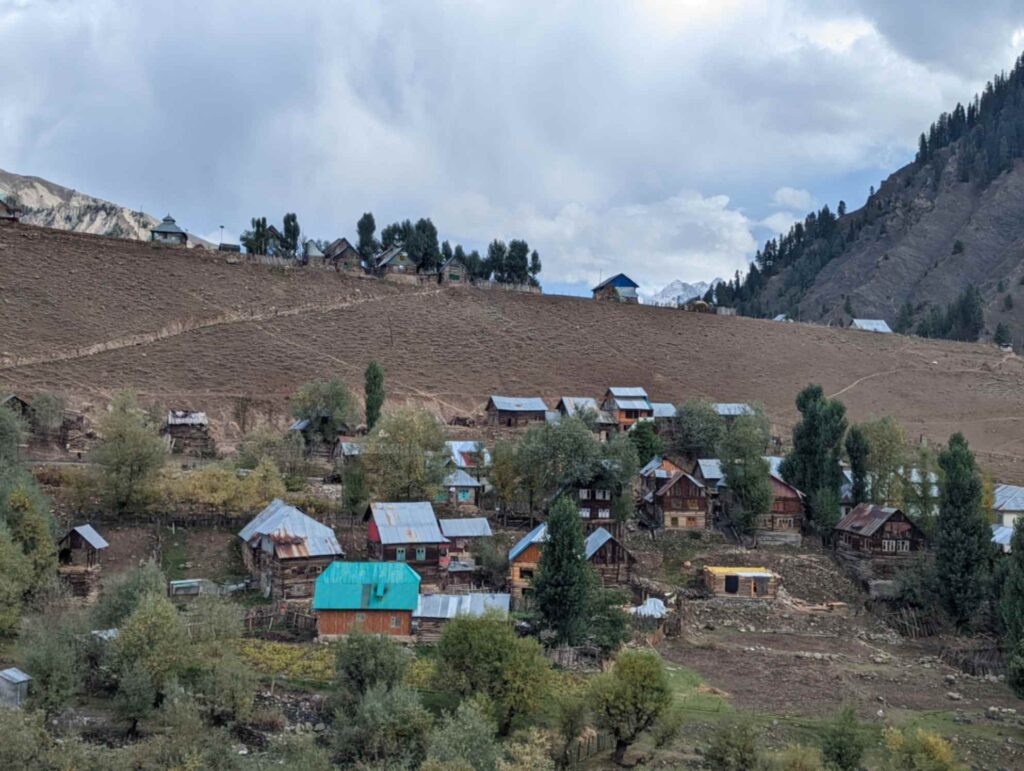
Here you spot old wooden houses clinging to hillsides, and fields carved like staircases into the earth.
Children run barefoot on grass, goats nibble at wildflowers, and time forgets to tick.
You share meal with a family who has never left the valley not because they can’t, but because they never wanted to.
Badogam holds you in a silence that’s not empty but which is whole.

Angaikot
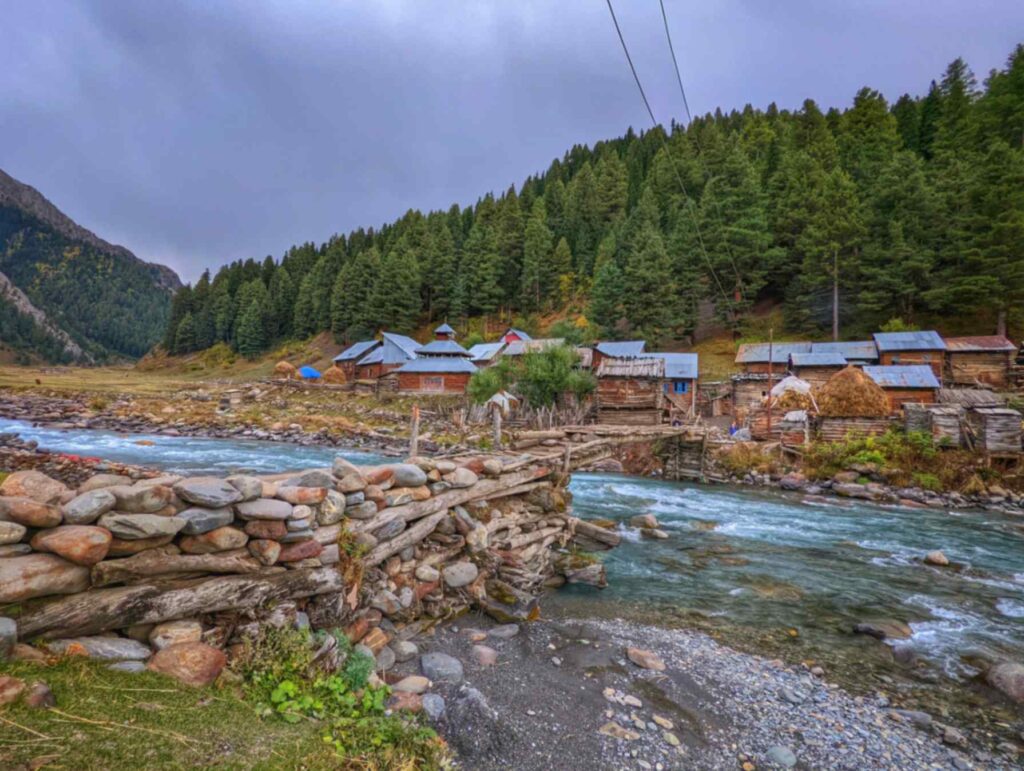
You just can’t miss Angaikot. This is the farthest village which you would be allowed to travel. You can’t go beyond Angaikot, Army won’t allow you.
Angaikot is not flashy or loud. It’s the poet of Tulail Valley as it is quiet, reflective, and deeply emotional.

The air is crisp, and the Kishanganga gushes here like a mad queen. As you walk further, the river murmurs you, like it’s reciting poetry meant only for those who listen closely.
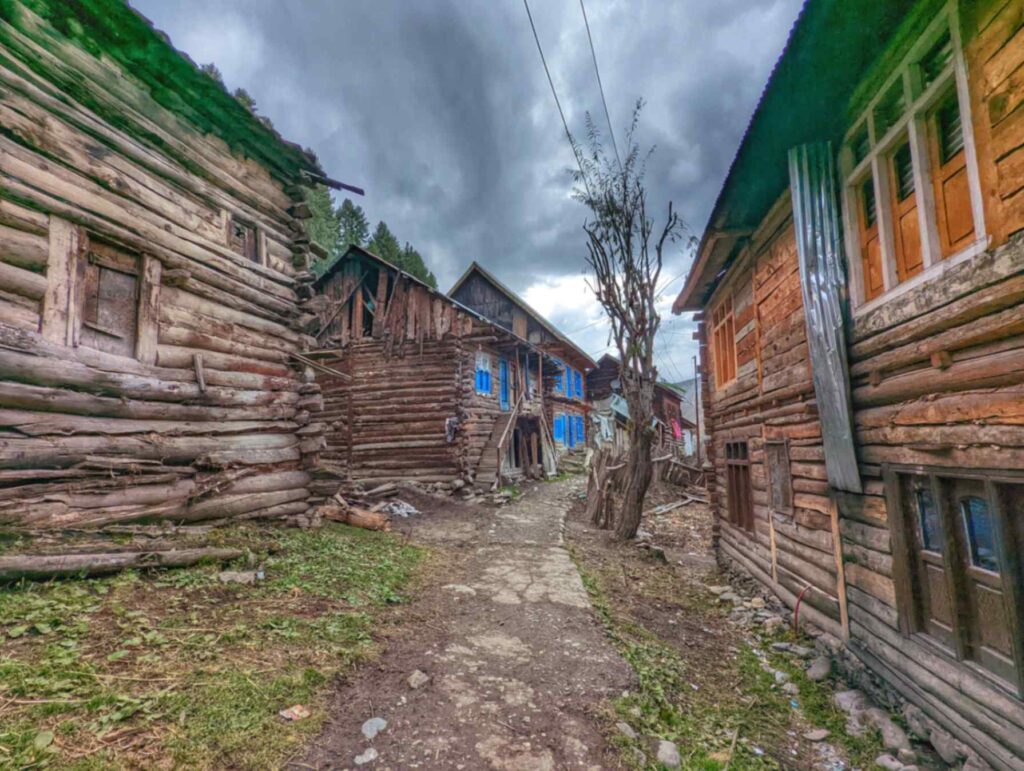
You wander narrow paths lined with tiny wooden homes, mossy stones, and an old woman invites you in for tea without asking your name. And she talks fully from her heart . And you listen, spellbound, realizing this village hasn’t been forgotten by the world. It simply chose not to raise its voice.
Sheikhpora
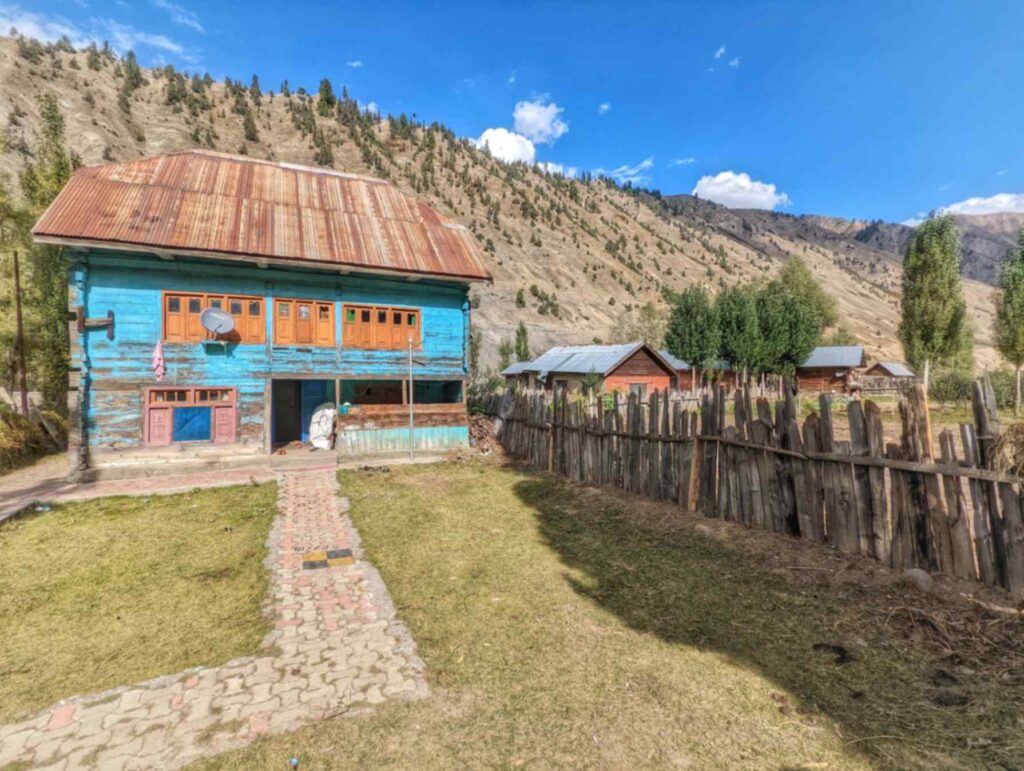
This village is Tulail Valley’s heartbeat and also the most accessible one. Sheikhpora village feels like the valley’s heartbeat, steady, strong, quietly powerful.
You stand at the edge of Sheikhpora, a tiny hamlet tucked away in the folds of Tulail Valley, where the world seems to exhale peace with every breath of the breeze.
The road behind you is nothing more than a winding trail of dust and determination, far from the noise, the horns, the hurry. Ahead, a quiet village opens up, wrapped in wooden homes and the scent of woodsmoke drifting lazily from chimney tops.
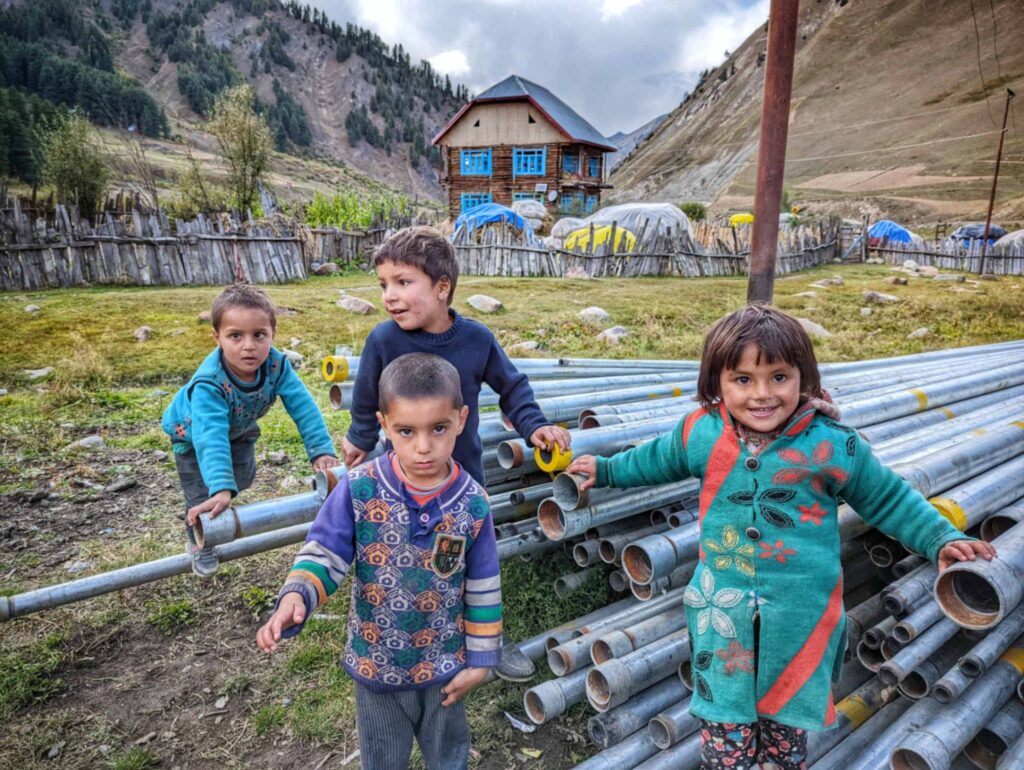
The people here nod at you with shy eyes and warm smiles, their words few, but gestures rich. You pass children playing with wooden sticks, crafting dreams without screens.
Life here is slow, but not stagnant, each moment seems to matter more, weighed in silence and stitched with simplicity.
Sheikhpora doesn’t try to impress you. It simply is. And that’s its magic.
And As You Leave…
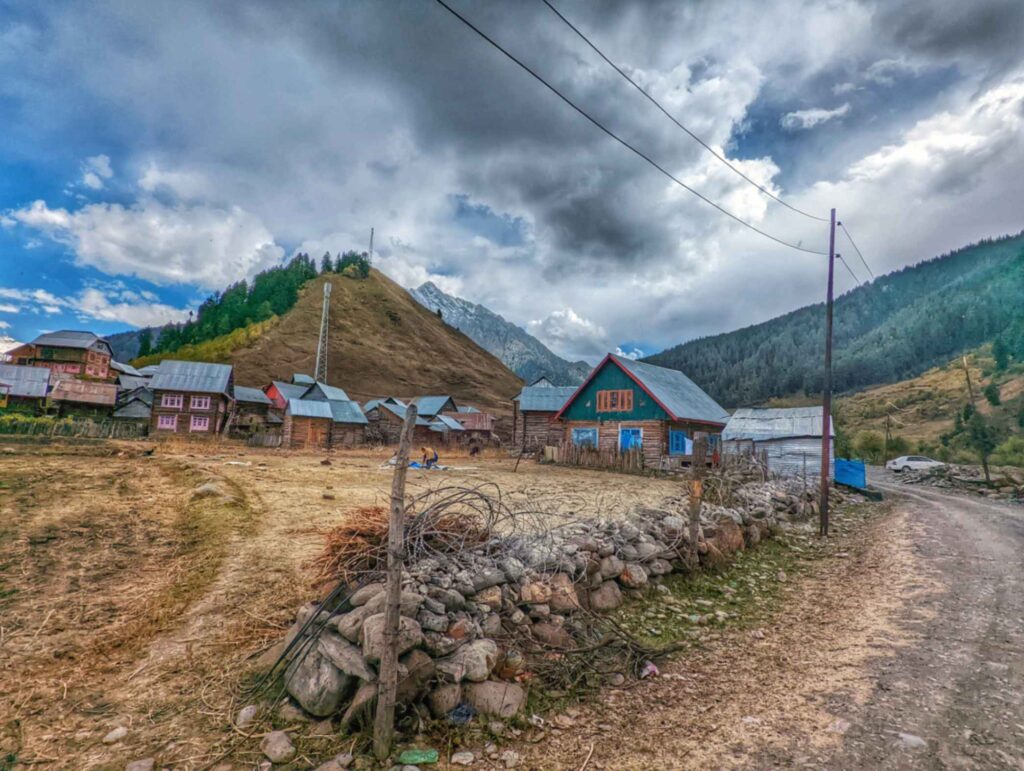
The road winds back out of Tulail Valley, but a part of you stays behind, in Barnoi’s silence, Husangam’s stories, Badogam’s air, Angaikot’s poetry, and Sheikhpura’s heartbeat.
You don’t cry when you leave, but your soul bows in gratitude. Because Tulail Valley’s timeless villages didn’t just show you beauty, they showed you how to be still, how to listen, and how to feel home in the quiet.
Kishanganga: A River Beyond Borders
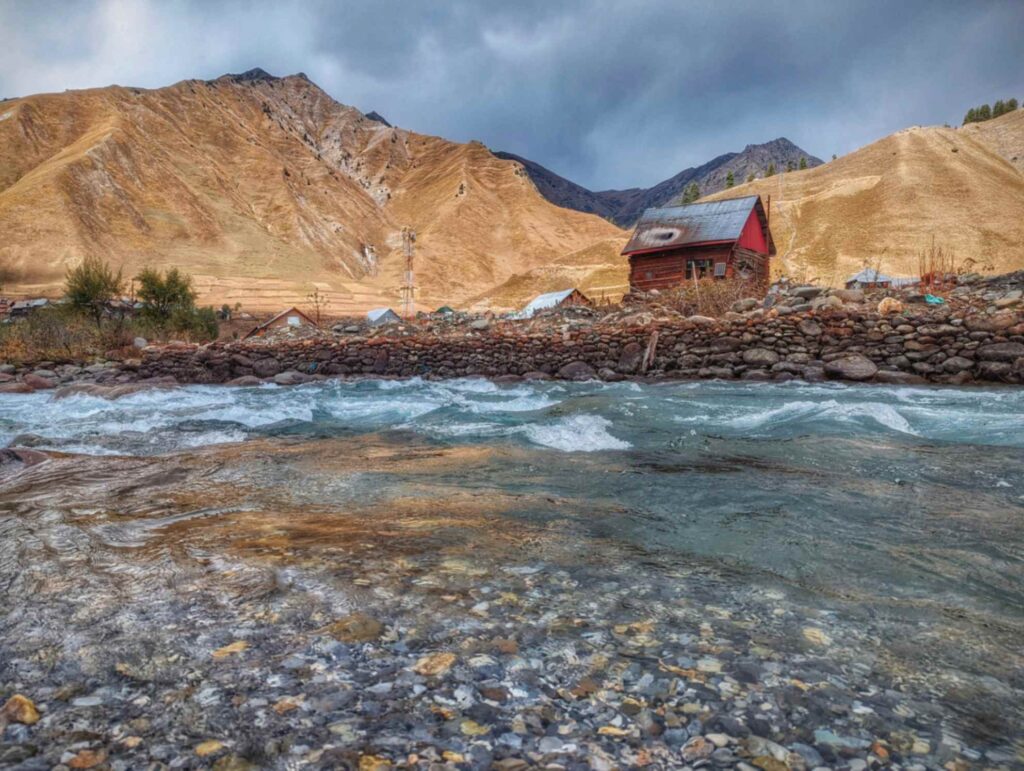
The most striking feature of Tulail valley is it’s beautiful deep blue Kishanganga river.
The Kishanganga River, known as the Neelam River in Pakistan-occupied Kashmir, is a symbol of natural unity beyond political borders.
Though divided by the Line of Control (LoC), she connects the people, cultures, and landscapes of Jammu & Kashmir (India) and Pakistan in a way that no boundary can erase.
Origin: Kishanganga originates in India’s Jammu & Kashmir, near the Kishansar Lake.
Flow in India: She winds through the Tulail and Gurez Valley and make her path through lush meadows and snow-capped peaks.
Crossing the LoC: The river then enters Neelam Valley in Pakistan-occupied Kashmir, where she is renamed as Neelum.
Merging Point: Eventually, she joins the Jhelum River near Muzaffarabad, Pakistan.
This serene river has historical and cultural importance for both sides, with local folklore and traditions linked to it. Hence she is a symbol of natural unity beyond political borders.
Despite political tensions, Kishanganga or Neelum river continues to flow freely, nourishing lands and linking people in ways that diplomacy often fails to. She serves as a reminder of a shared past and the potential for a peaceful future.
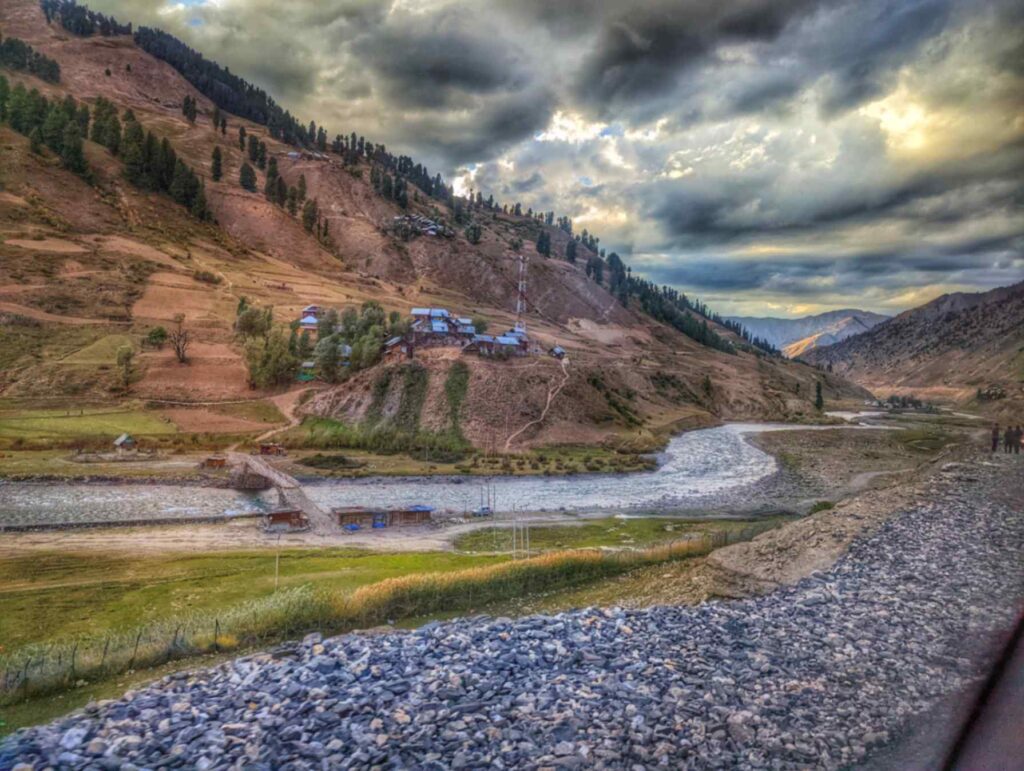
A Poetic Tribute to River Kishanganga/Neelam from My Pen
It was during the Kashmir Great Lakes trek, that I saw glimpse of Kishanganga for the first time.
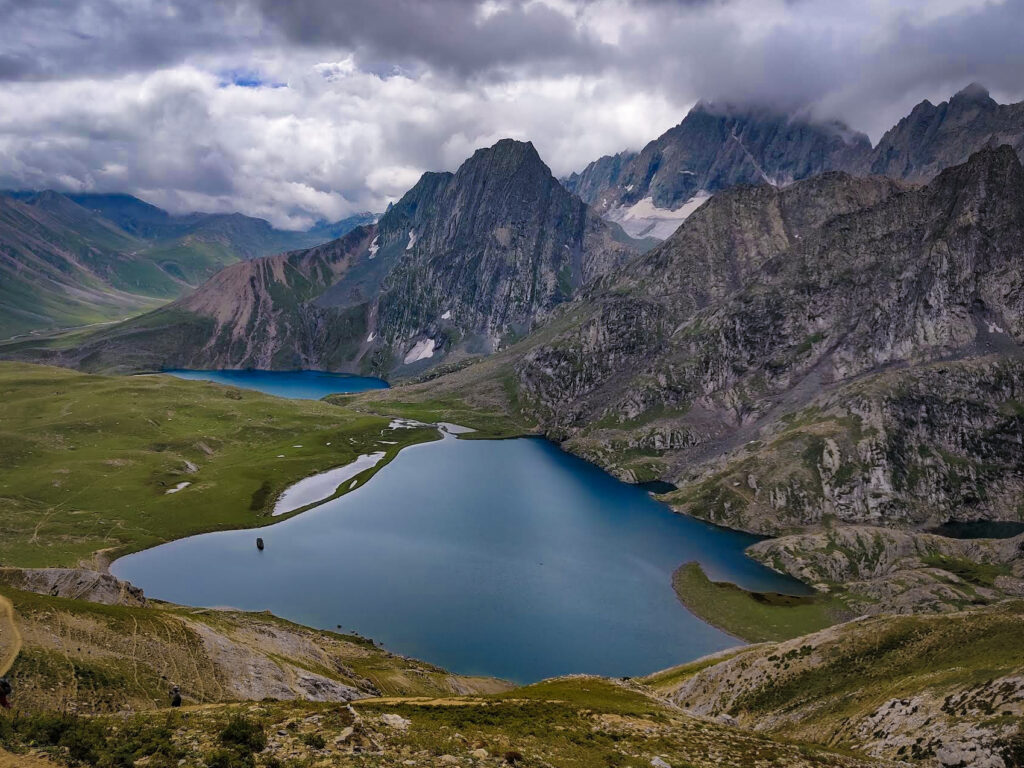
For most of the time my eyes were focused on the mighty Kishansar lake. Kishanganga was a tiny blue stream rising out from Kishansar lake. Further, when I travelled to Tulail valley, I saw her in her full glory.
Kishanganga absolutely blew my mind as well as my heart with her mesmerizing charm of crystal clear blue waters. Not only this river is rich in beauty, but also in history, geography and culture.
Sindhu, Jhelum, Ravi, Chenab, Beas and Sutlaj are the major rivers which transverse from India to Pakistan. However all these rivers have a common name in both the countries. And this is what which made Kishanganga unique in my eyes. Indo- Pak border changes her name from Kishanganga to Neelam.
Kishanganga means Blue Ganga.
Neelam means Blue stone or Sapphire.
Two enemy countries! Two names! But One River! One common meaning!
Blue colour is my favourite colour. How can I stop getting fascinated by the river who has blue in her name?
Oh God! I was completely schmitten with the beauty and history of Kishanganga.
Schmitten enough to write a poem for her!
I have never ever written any poem. However I used to enjoy the 32 figures of speech lectures, back in school. Out of these 32 figures of speech, Personification is my most favourite. Hence through this poem, I have done an attempt to personify River Kishanganga/Neelam.
For a more personal feel, I have written this poem in 2nd person narrative.
River Kishanganga / Neelam: You Know No Boundaries
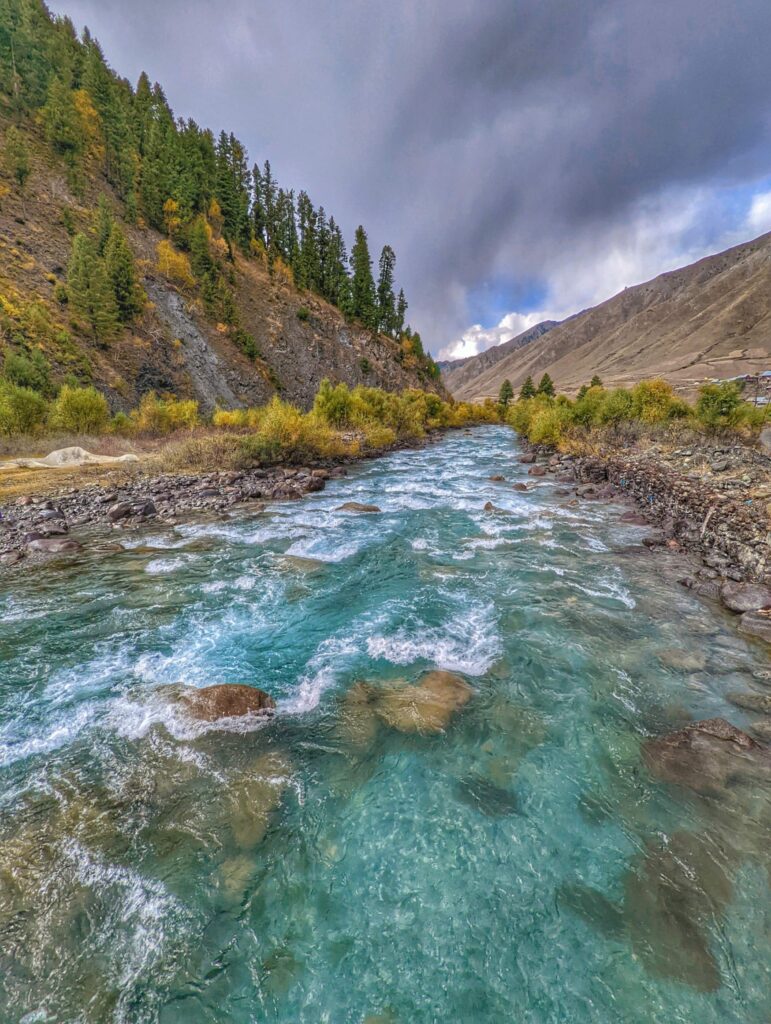
Since you were tiny, you made your father proud,
Daughter of Kishansar, you stand out of crowd.
You inherit your beauty from your dad's grace,
A father so handsome, no doubt you own pretty face!
Mount Harmukh stands silent and cold,
Under his presence, you grew up to be so bold.
As a mighty elder brother, he always guards you,
With such a tall brother, nobody dares to touch you.
You carve your own path, being wild and free,
A deep blue thread from snow to sea.
They call you Kishanganga here,
Neelam there, but you are a deaf to hear.
Himalayas rise, borders stand,
Mortals draw line by blood stained hand.
Yet you flow untamed, unchained,
Through lands once whole, now rearranged.
They draw their lines, they build their walls,
Yet your waters nourish all, ignoring their calls.
Courageous rivers like you do not yield,
No war can control the power that you wield.
You touch two lands, yet belong to none,
As your mighty waters do not fear any gun.
You speak no language, yet all understand,
As your voice has the touch of nature’s hand.
Your waters dance, your currents race,
For no boundary can limit your grace.
You know no master, no chain, no fate,
Through conflict and peace, you hold your state.
Unshaken by the marks of men,
You carve your path and rise again.
Forever strong, forever true,
Kishanganga, I am deeply amazed by you.
They spill their blood upon your bank for honour,
In gallant battles fought with extreme valour.
Yet when you flood, the land is clean,
No sign of what their wars have been.
After wiping the blood on the Lines of Control,
You longed for kin to comfort your soul.
Then you called the Verinag's daughter,
Your sister Jhelum, for some laughter.
Treacherous Jhelum river gave you a greet,
Trusting your elder sister, you went to meet.
Yet she betrayed you and dissolved your name,
Still, you flood her veins, fueling her fame.
Mortals fight tooth and nail for name and fame,
Immortals don't carry shame after losing name.
You lost your name and fame at the confluence,
Still, you never lost your elegant influence.
You got overshadowed by your own sister,
You don't seek revenge or make her shiver.
Any mortal would avenge in such circumstance,
Immortal heir of Kishansar knows no vengeance.
Oh mighty Kishanganga, you are truly immortal,
How can Lord Harmukh's sister be a mere mortal?
By personifying you, my pen committed a grave sin,
Wash my sins with your water and make me clean.
This poem is a tribute to you, dear Kishanganga/Neelam.
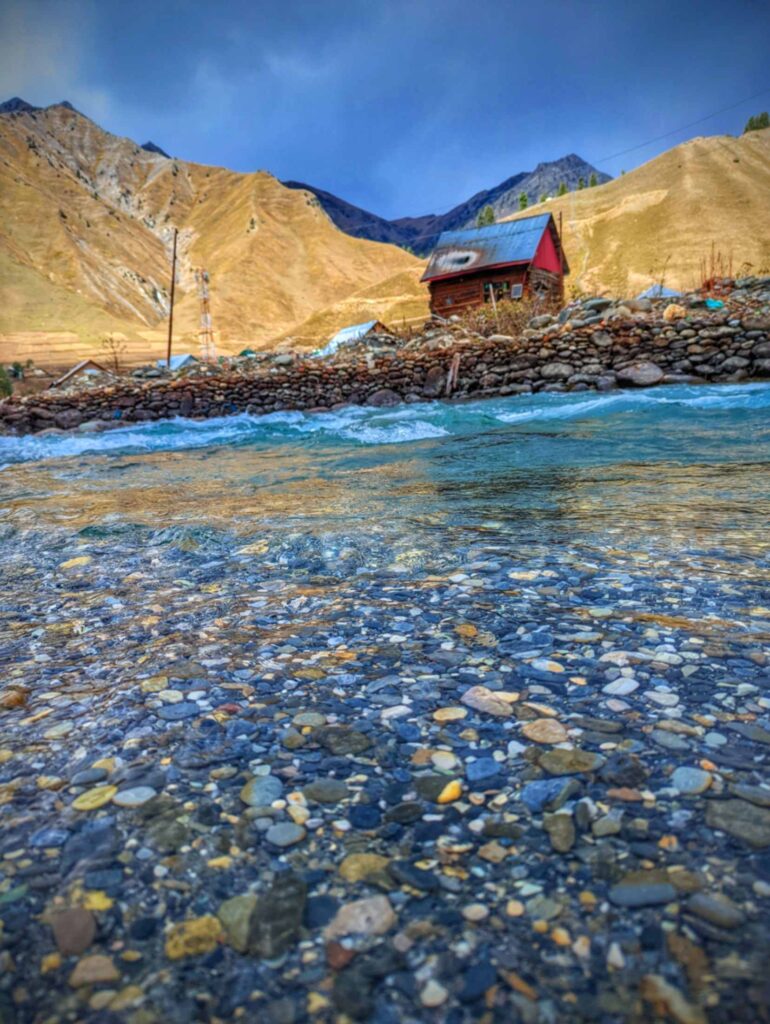
I have never owned any real sapphire!
And I am not that rich enough to buy natural pure sapphire.
But with your blue name, with your deep blue waters, you have filled my poor pen with pure natural sapphire!
And for this, I am forever grateful to you🙏.
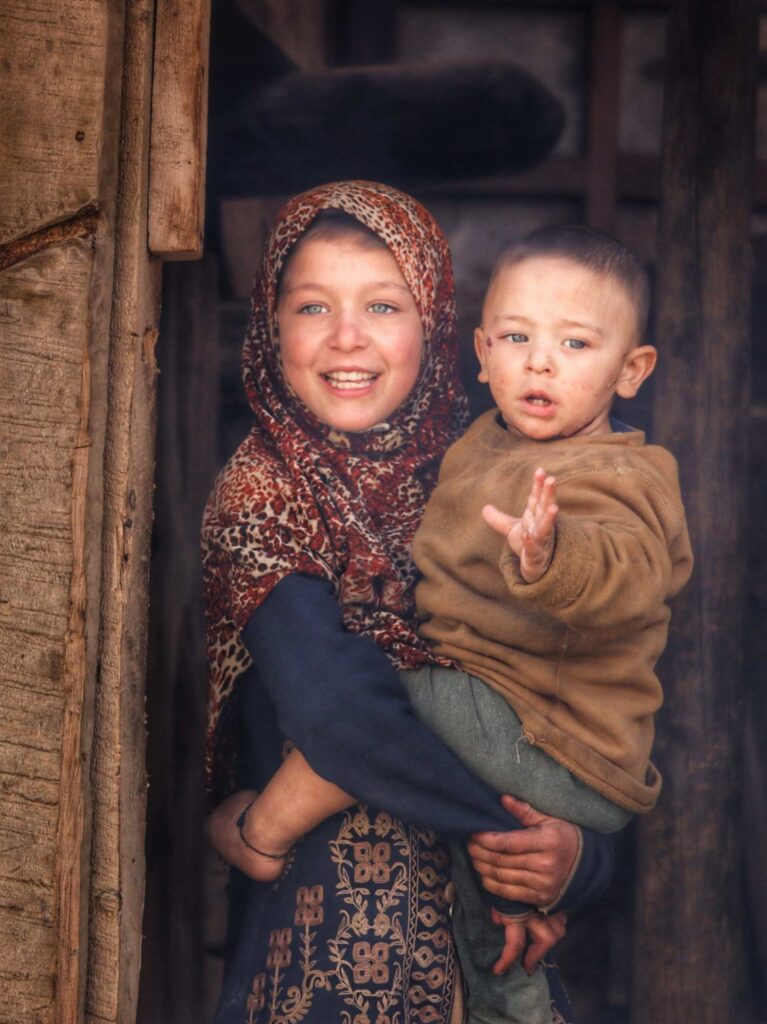
The Remarkable Heritage of the Dard and Shina Tribe: History, Culture & Legacy
Tulail Valley is the land of Dard and Shina tribe.
The Dard and Shina tribe stands as a powerful symbol of cultural endurance and diversity in the mountainous regions of in the rugged terrains of northern Pakistan, parts of India’s Jammu & Kashmir, and some areas of Afghanistan.
These tribes trace their roots to ancient Indo-Aryan civilizations and they are known for their distinct language, customs, and resilience, they have kept their identity alive for centuries.
Historical Origins of the Dard People

The Dardic people are part of a larger Indo-Aryan ethnolinguistic group known for their presence in the remote valleys of the Hindu Kush and western Himalayas.
Linguists and historians suggest the Dards are remnants of early Indo-Aryan tribes who migrated eastwards from Central Asia and settled in the northwestern subcontinent. Over time, their language and customs diverged significantly due to geographical isolation and intermingling with neighboring tribes.
Geographic Distribution
Today, Dardic tribes, including the Shina-speaking communities, inhabit:
Gilgit-Baltistan (Pakistan)
Chitral and Kohistan (Pakistan)
Kargil and Dras regions of Ladakh (India)
Nuristan and Badakhshan (Afghanistan)
These regions are mountainous and often cut off during winter, contributing to the preservation of unique customs and dialects.
Understanding the Shina Subgroup
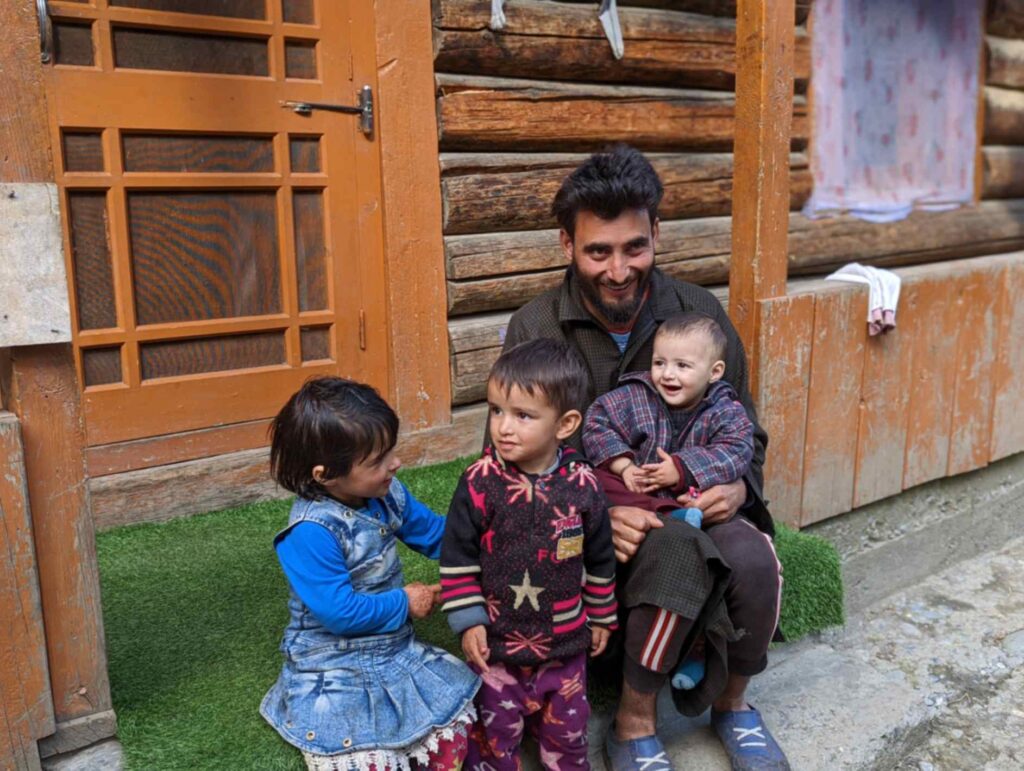
The Shina are one of the largest and most culturally rich subgroups within the Dardic family. They primarily live in Gilgit-Baltistan, with smaller populations in Chilas, Kohistan, and parts of India. What sets the Shina people apart is their dialect, social customs, and oral history.
Languages and Dialects
The Shina language is a key identifier for the tribe. It belongs to the Dardic group of the Indo-Aryan language family and has several dialects:
Standard Shina (spoken in Gilgit)
Astori Shina
Kohistani Shina
Drasi Shina
Religious Beliefs and Spiritual Practices
Historically, the Dardic tribes followed a mix of animism, Hinduism, and local spiritual traditions.
With the arrival of Islam—especially through Sufi missionaries in the 14th century—the majority of the Dard and Shina tribes converted to Sunni or Shia Islam, depending on the region.
Economic Activities and Livelihoods
Agriculture is the backbone of the Dard and Shina economy. People grow peas, potatoes and raise livestock like goats and sheep.
Nowadays people have started to earn from local tourism also.
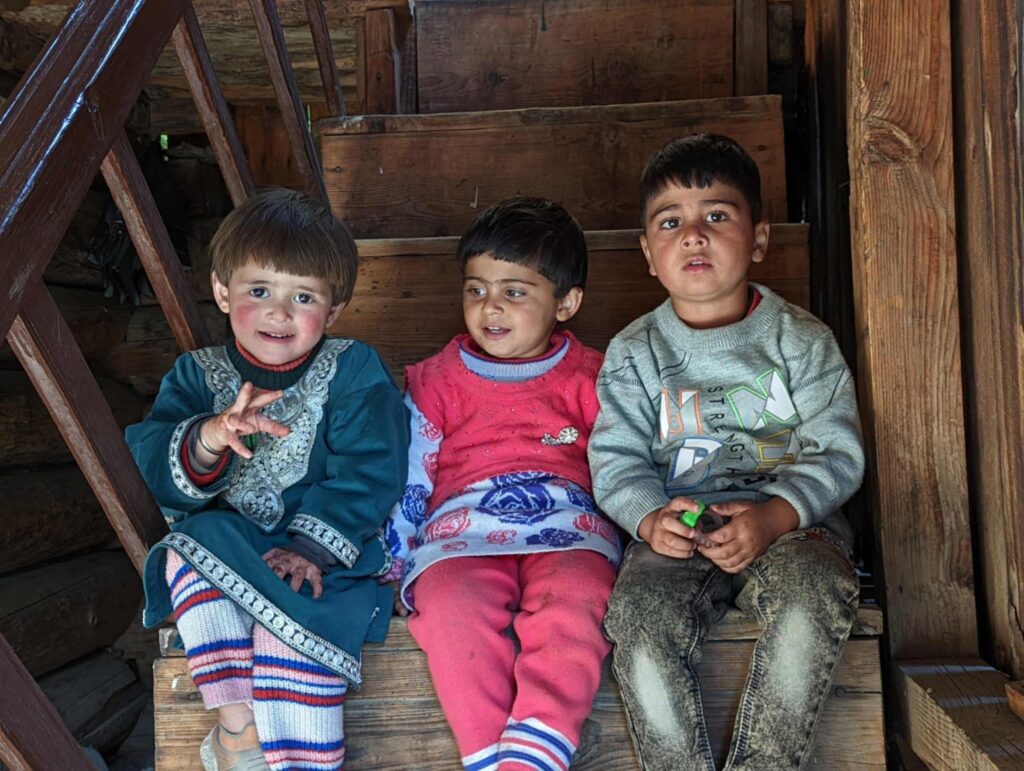
Challenges Facing the Dard and Shina Tribe Today
Despite their vibrant culture, the tribe faces challenges:
Cultural erosion due to urbanization
Language endangerment
Less political representation
Environmental threats like glacial flooding
Despite these hardships, the Dard and Shina-speaking communities in Tulail Valley continue to preserve their rich cultural heritage, traditions, and resilience in the face of adversity. Government initiatives, tourism promotion, and better connectivity could help improve their quality of life.
Planning Your Tulail Valley Travel: Estimated Costs and Expenses
Budget hotels or homestays range from ₹800–₹2,000 per night.
Meals are affordable at ₹400–₹800 per person daily.
Most expensive part of travelling to Tulail valley is hiring a vehicle.
In comparison with other Indian states, cost for renting a vehicle is extremely high in Kashmir.
Cost of Innova which we hired – Rs 6000 per day without fuel and without driver.
You can also book cab with driver from Srinagar. This option will come with driver and fuel, however this option won’t give you complete flexibility. This is because most of the drivers will keep on pestering you to go into tourist hubs like Gulmarg and Pahalgam.
Dos and Don’ts for Visiting Politically Sensitive Areas Like Tulail Valley

Traveling to India’s most politically sensitive area of LoC isn’t like any ordinary trip.
This is a journey into a land where history, tension, and breathtaking beauty coexist simultaneously!
Every step you take carries weight, demanding not just curiosity but also caution, respect, and a deep sense of responsibility.
One wrong move, an unintentional remark, or a simple misunderstanding can turn your adventure into a challenge.
This guide will equip you with the essential dos and don’ts to ensure your journey is safe, respectful, and unforgettable.
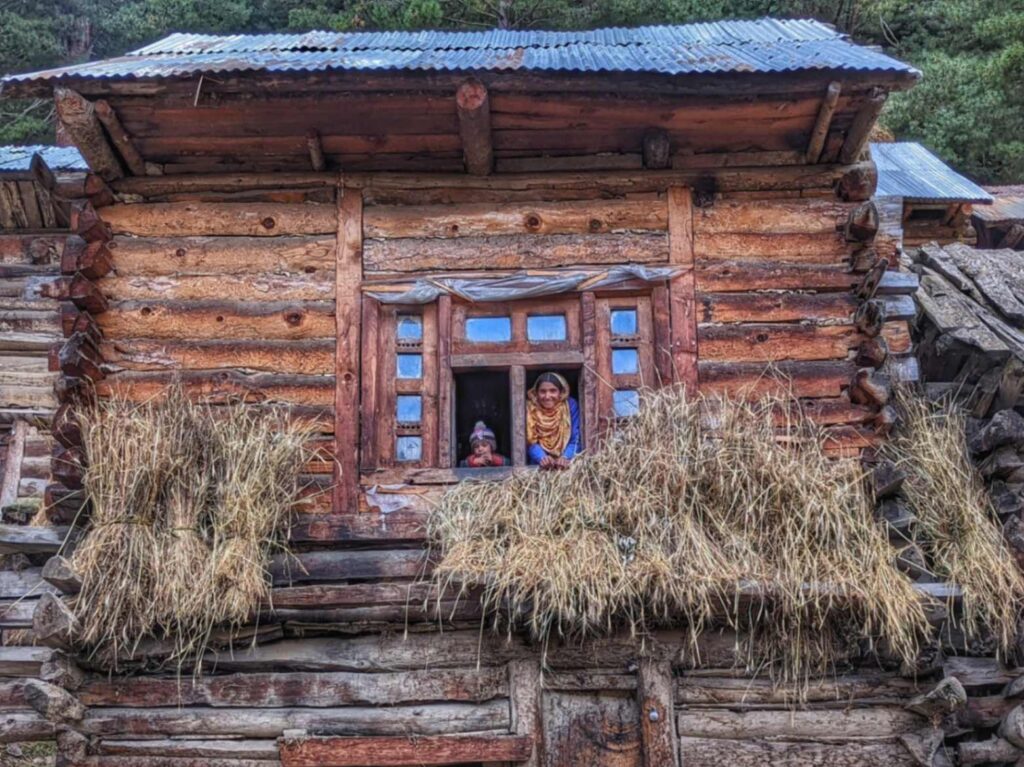
Understanding the sensitivity of LoC near Tulail valley
The first thing you must understand is that Tulail Valley is a serene and untouched land with complex geopolitics as it is located near the Line of Control (LoC)—the de facto border between India and Pakistan.
The LoC near Tulail Valley is one of the most heavily guarded regions in the world.
The Indian Army maintains a strong presence to safeguard the border from infiltration and potential security threats. Frequent patrolling, military checkpoints, and surveillance are common.
Locals are accustomed to the presence of security forces and have adapted to life under military oversight.
While the area remains relatively stable today, periodic ceasefire violations and border tensions still occur.
✅ Dos: What You Should Do In Tulail valley?
1. Research & Plan Your Trip Thoroughly
Check government travel advisories and security updates before planning your trip. Identify safe zones and restricted areas along the LoC.
2. Obtain Documentation
Always carry valid identification (passport, Aadhaar, voter ID). Original documents are required.
Register at local police stations or army checkpoints if required.
3. Respect Local Customs & Culture
The people living in this region have deep-rooted traditions; be mindful of their customs. Dress modestly and avoid any behavior that could be seen as disrespectful.
4. Follow Security Protocols
Always cooperate with security forces and follow their instructions. If you’re stopped at a military checkpoint, provide your documents politely.
5. Travel Responsibly & Sustainably
Minimize your environmental impact by avoiding littering.
Support local businesses and communities by purchasing handmade goods and using local services.
🚫 Don’ts: What You Should Avoid in Tulail valley ?
1. Don’t Discuss Politics or Security Issues
Avoid political discussions about Kashmir, the LoC, or military actions.
Do not engage in debates with locals or security personnel on sensitive topics.
Refrain from making social media posts that could be misinterpreted.
2. Don’t Wander Into Restricted Zones
Some areas are off-limits to civilians. Do not attempt to access them.
Stay on designated paths and routes for your safety.
Do not ignore warning signs or instructions from the military.
3. Don’t Take Unauthorized Photos or Videos
Avoid photographing army bases, bunkers, and military personnel. This can lead to serious consequences.
Drone photography is strictly prohibited in Tulail valley. Only mobile phone photography and DSLRs are allowed.
4. Don’t Travel Without a Backup Plan
Have an emergency contact list.
Download offline maps. Take extra batteries in case of power or network outages. Be prepared for sudden curfews or lockdowns, which can occur due to security threats. Keep buffer days.
5. Don’t Disrespect Local Norms or Traditions
Avoid public displays of affection, as the region is culturally conservative.
Don’t consume alcohol or drugs, especially in public places.
Be respectful in religious sites and gatherings.
Tulail Valley Awaits You!
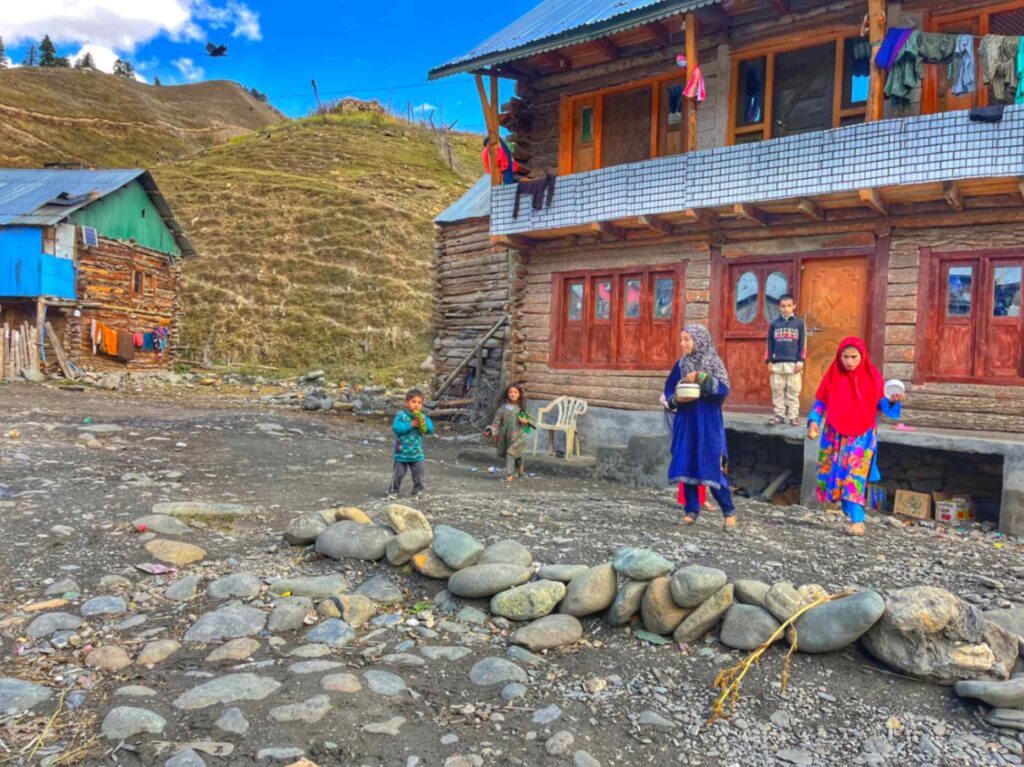
Do you dare to travel to Tulail Valley?
Beyond the beaten paths, where time slows and nature whispers its ancient secrets, lies the wild and untamed Tulail valley.
Few have wandered its mystical trails, fewer still have unraveled its hidden wonders.
The question is—do you dare?
If the blood of uncharted traveling runs through your veins then Tulail Valley must be your next great escape.
Just enter into the wilderness and beautiful Tulail valley tell you stories only the boldest travelers ever hear.
Your journey into the unknown begins now—will you take the first step?
If you have loved this blog, then I am sure that you have been mesmerized by the beauty of Kashmir.
For reading more about the beauty of Kashmir, don’t forget to checkout the following blog.
Kashmir Through My Eyes: A Tale of Land of Timeless Beauty
FAQs
What makes Tulail Valley different from other valleys in Kashmir?
When you step into Tulail Valley, it feels like you’ve entered a postcard. Unlike the popular and sometimes crowded valleys of Kashmir, Tulail offers you pure solitude and untouched beauty. You won’t find too many hotels or tourists here. Instead, you’ll get sweeping alpine views, peaceful riverside villages, and raw Himalayan charm. It’s perfect if you’re craving quiet, connection with nature, and a chance to truly disconnect from the chaos.
What is the best time to visit Tulail Valley?
You’ll want to plan your trip between late May and early October. That’s when the roads are clear of snow, and the valley is alive with wildflowers, green meadows, and postcard-perfect views. If you visit in June or July, you’ll see the landscape at its most vibrant. But if you prefer quiet and don’t mind a bit of chill, September offers golden autumn colors and fewer travelers. Just avoid the winter months—Tulail gets cut off due to heavy snowfall, making access nearly impossible.
What should you pack for a trip to Tulail Valley?
Layers—lots of them! Even in summer, the temperatures can drop fast, especially at night. Pack warm clothes, waterproof shoes, sunscreen, power banks (since electricity can be patchy), and any medicine you might need. There aren’t many shops around, so bring your essentials. And don’t forget your camera—because trust me, you’ll want to capture every inch of this hidden Himalayan gem.
Do you need to carry cash while visiting Tulail Valley?
Yes—definitely carry cash. Once you’re past Bandipora, ATMs are practically nonexistent, and digital payments aren’t common in Tulail. Most homestays, local shops, and taxi drivers deal only in cash. So stock up before you leave Bandipora or Srinagar, and keep small denominations handy. It’ll save you a lot of hassle in the mountains.
Will you need any special documents at army checkpoints?
Yes, you’ll likely pass a few army checkpoints, especially at Razdan Pass and near the LoC. Make sure you carry a valid government-issued photo ID at all times. Indian citizens usually won’t have trouble, but the army may ask about your destination and duration of stay. Just be cooperative and polite—they’re there for your safety.

